Haoxian Zhang
Learning Audio-Driven Viseme Dynamics for 3D Face Animation
Jan 15, 2023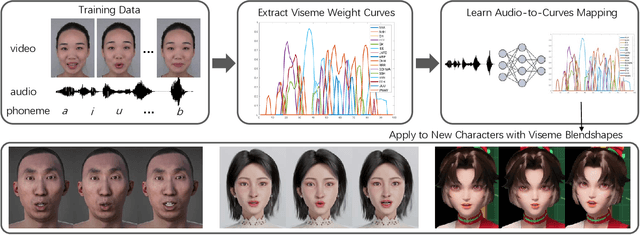

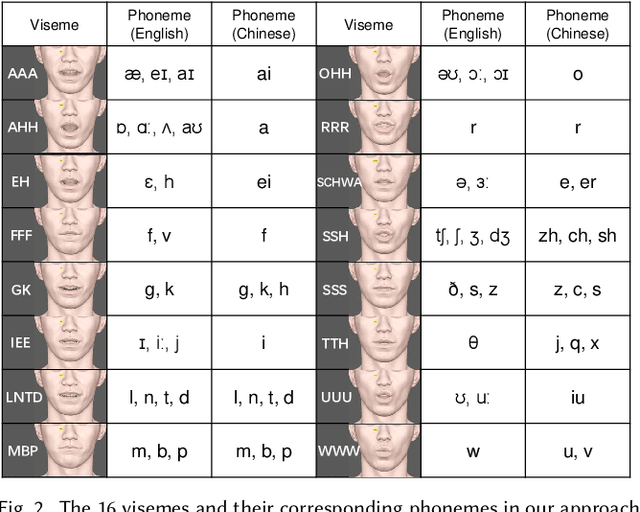
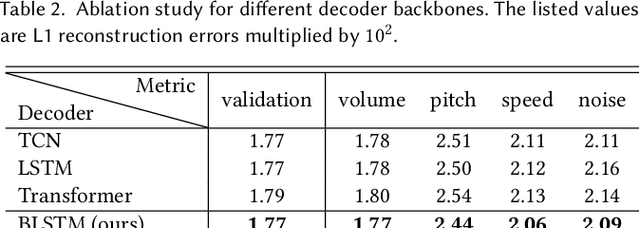
Abstract:We present a novel audio-driven facial animation approach that can generate realistic lip-synchronized 3D facial animations from the input audio. Our approach learns viseme dynamics from speech videos, produces animator-friendly viseme curves, and supports multilingual speech inputs. The core of our approach is a novel parametric viseme fitting algorithm that utilizes phoneme priors to extract viseme parameters from speech videos. With the guidance of phonemes, the extracted viseme curves can better correlate with phonemes, thus more controllable and friendly to animators. To support multilingual speech inputs and generalizability to unseen voices, we take advantage of deep audio feature models pretrained on multiple languages to learn the mapping from audio to viseme curves. Our audio-to-curves mapping achieves state-of-the-art performance even when the input audio suffers from distortions of volume, pitch, speed, or noise. Lastly, a viseme scanning approach for acquiring high-fidelity viseme assets is presented for efficient speech animation production. We show that the predicted viseme curves can be applied to different viseme-rigged characters to yield various personalized animations with realistic and natural facial motions. Our approach is artist-friendly and can be easily integrated into typical animation production workflows including blendshape or bone based animation.
FFHQ-UV: Normalized Facial UV-Texture Dataset for 3D Face Reconstruction
Nov 25, 2022Abstract:We present a large-scale facial UV-texture dataset that contains over 50,000 high-quality texture UV-maps with even illuminations, neutral expressions, and cleaned facial regions, which are desired characteristics for rendering realistic 3D face models under different lighting conditions. The dataset is derived from a large-scale face image dataset namely FFHQ, with the help of our fully automatic and robust UV-texture production pipeline. Our pipeline utilizes the recent advances in StyleGAN-based facial image editing approaches to generate multi-view normalized face images from single-image inputs. An elaborated UV-texture extraction, correction, and completion procedure is then applied to produce high-quality UV-maps from the normalized face images. Compared with existing UV-texture datasets, our dataset has more diverse and higher-quality texture maps. We further train a GAN-based texture decoder as the nonlinear texture basis for parametric fitting based 3D face reconstruction. Experiments show that our method improves the reconstruction accuracy over state-of-the-art approaches, and more importantly, produces high-quality texture maps that are ready for realistic renderings. The dataset, code, and pre-trained texture decoder are publicly available at https://github.com/csbhr/FFHQ-UV.
Smooth image-to-image translations with latent space interpolations
Oct 03, 2022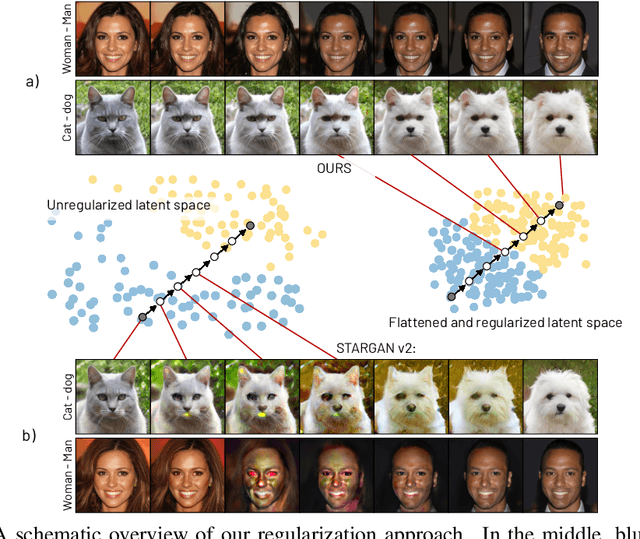
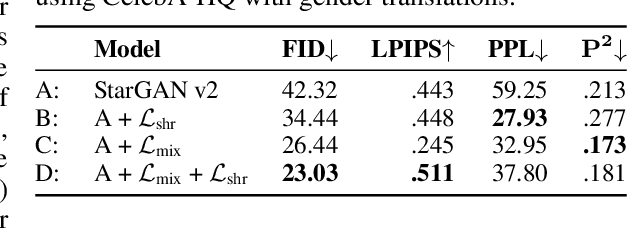
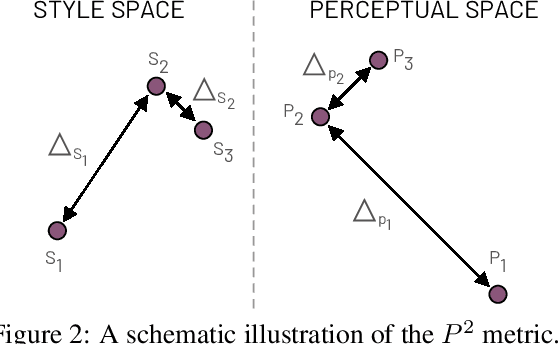

Abstract:Multi-domain image-to-image (I2I) translations can transform a source image according to the style of a target domain. One important, desired characteristic of these transformations, is their graduality, which corresponds to a smooth change between the source and the target image when their respective latent-space representations are linearly interpolated. However, state-of-the-art methods usually perform poorly when evaluated using inter-domain interpolations, often producing abrupt changes in the appearance or non-realistic intermediate images. In this paper, we argue that one of the main reasons behind this problem is the lack of sufficient inter-domain training data and we propose two different regularization methods to alleviate this issue: a new shrinkage loss, which compacts the latent space, and a Mixup data-augmentation strategy, which flattens the style representations between domains. We also propose a new metric to quantitatively evaluate the degree of the interpolation smoothness, an aspect which is not sufficiently covered by the existing I2I translation metrics. Using both our proposed metric and standard evaluation protocols, we show that our regularization techniques can improve the state-of-the-art multi-domain I2I translations by a large margin. Our code will be made publicly available upon the acceptance of this article.
HVC-Net: Unifying Homography, Visibility, and Confidence Learning for Planar Object Tracking
Sep 19, 2022
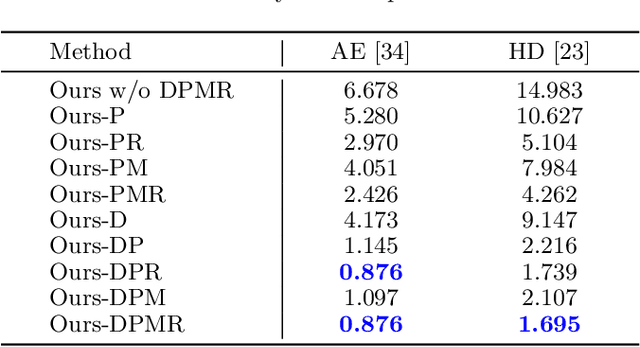


Abstract:Robust and accurate planar tracking over a whole video sequence is vitally important for many vision applications. The key to planar object tracking is to find object correspondences, modeled by homography, between the reference image and the tracked image. Existing methods tend to obtain wrong correspondences with changing appearance variations, camera-object relative motions and occlusions. To alleviate this problem, we present a unified convolutional neural network (CNN) model that jointly considers homography, visibility, and confidence. First, we introduce correlation blocks that explicitly account for the local appearance changes and camera-object relative motions as the base of our model. Second, we jointly learn the homography and visibility that links camera-object relative motions with occlusions. Third, we propose a confidence module that actively monitors the estimation quality from the pixel correlation distributions obtained in correlation blocks. All these modules are plugged into a Lucas-Kanade (LK) tracking pipeline to obtain both accurate and robust planar object tracking. Our approach outperforms the state-of-the-art methods on public POT and TMT datasets. Its superior performance is also verified on a real-world application, synthesizing high-quality in-video advertisements.
REALY: Rethinking the Evaluation of 3D Face Reconstruction
Mar 18, 2022

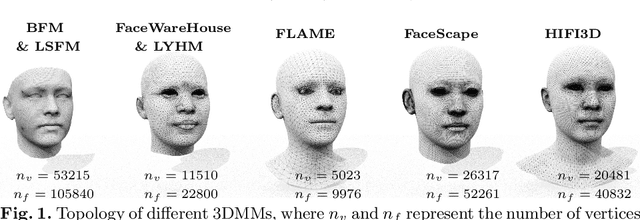

Abstract:The evaluation of 3D face reconstruction results typically relies on a rigid shape alignment between the estimated 3D model and the ground-truth scan. We observe that aligning two shapes with different reference points can largely affect the evaluation results. This poses difficulties for precisely diagnosing and improving a 3D face reconstruction method. In this paper, we propose a novel evaluation approach with a new benchmark REALY, consists of 100 globally aligned face scans with accurate facial keypoints, high-quality region masks, and topology-consistent meshes. Our approach performs region-wise shape alignment and leads to more accurate, bidirectional correspondences during computing the shape errors. The fine-grained, region-wise evaluation results provide us detailed understandings about the performance of state-of-the-art 3D face reconstruction methods. For example, our experiments on single-image based reconstruction methods reveal that DECA performs the best on nose regions, while GANFit performs better on cheek regions. Besides, a new and high-quality 3DMM basis, HIFI3D++, is further derived using the same procedure as we construct REALY to align and retopologize several 3D face datasets. We will release REALY, HIFI3D++, and our new evaluation pipeline at https://realy3dface.com.
Smoothing the Disentangled Latent Style Space for Unsupervised Image-to-Image Translation
Jun 16, 2021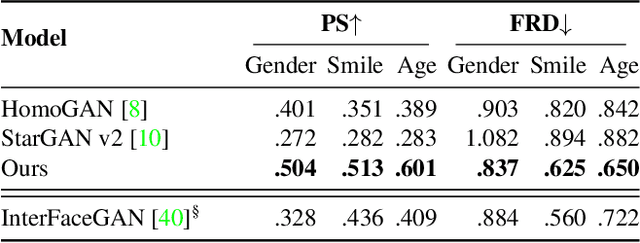

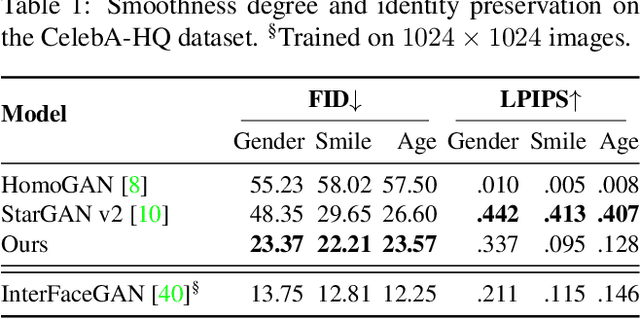
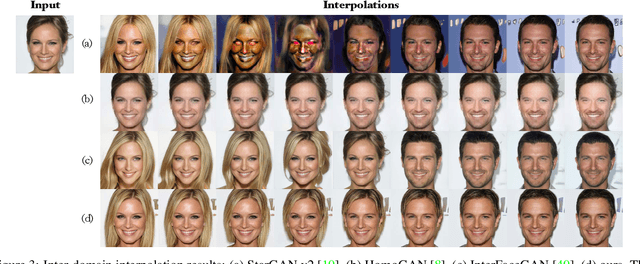
Abstract:Image-to-Image (I2I) multi-domain translation models are usually evaluated also using the quality of their semantic interpolation results. However, state-of-the-art models frequently show abrupt changes in the image appearance during interpolation, and usually perform poorly in interpolations across domains. In this paper, we propose a new training protocol based on three specific losses which help a translation network to learn a smooth and disentangled latent style space in which: 1) Both intra- and inter-domain interpolations correspond to gradual changes in the generated images and 2) The content of the source image is better preserved during the translation. Moreover, we propose a novel evaluation metric to properly measure the smoothness of latent style space of I2I translation models. The proposed method can be plugged into existing translation approaches, and our extensive experiments on different datasets show that it can significantly boost the quality of the generated images and the graduality of the interpolations.
High-Fidelity 3D Digital Human Creation from RGB-D Selfies
Oct 12, 2020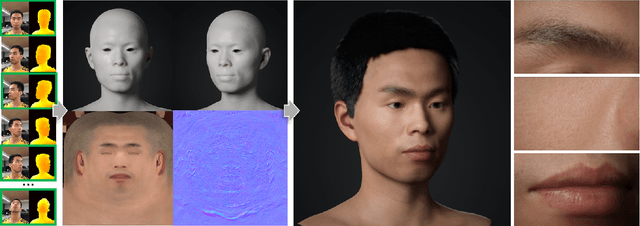

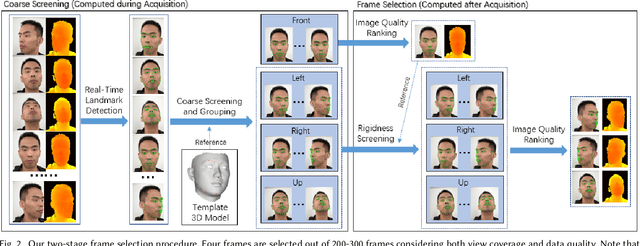

Abstract:We present a fully automatic system that can produce high-fidelity, photo-realistic 3D digital human characters with a consumer RGB-D selfie camera. The system only needs the user to take a short selfie RGB-D video while rotating his/her head, and can produce a high quality reconstruction in less than 30 seconds. Our main contribution is a new facial geometry modeling and reflectance synthesis procedure that significantly improves the state-of-the-art. Specifically, given the input video a two-stage frame selection algorithm is first employed to select a few high-quality frames for reconstruction. A novel, differentiable renderer based 3D Morphable Model (3DMM) fitting method is then applied to recover facial geometries from multiview RGB-D data, which takes advantages of extensive data generation and perturbation. Our 3DMM has much larger expressive capacities than conventional 3DMM, allowing us to recover more accurate facial geometry using merely linear bases. For reflectance synthesis, we present a hybrid approach that combines parametric fitting and CNNs to synthesize high-resolution albedo/normal maps with realistic hair/pore/wrinkle details. Results show that our system can produce faithful 3D characters with extremely realistic details. Code and the constructed 3DMM is publicly available.
 Add to Chrome
Add to Chrome Add to Firefox
Add to Firefox Add to Edge
Add to Edge